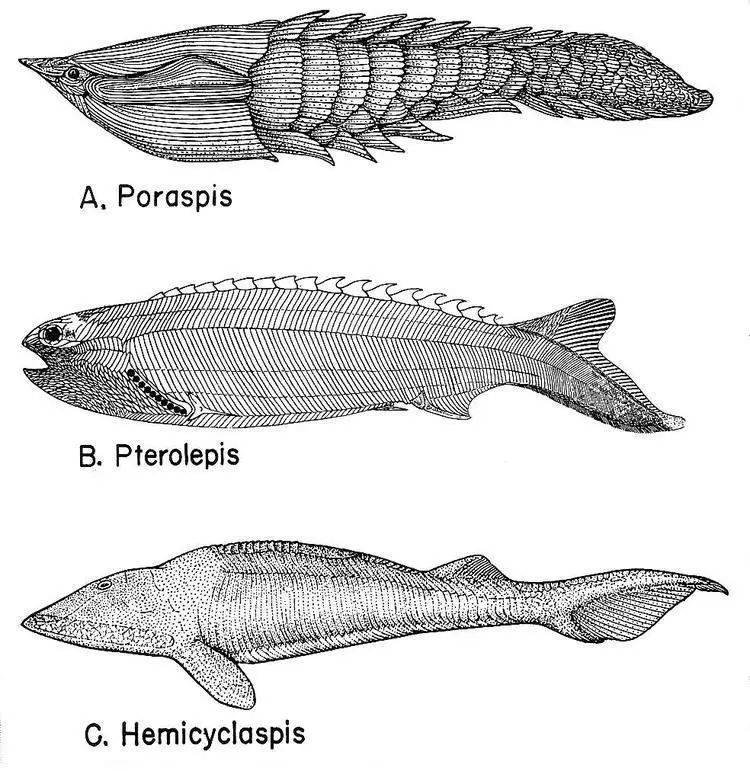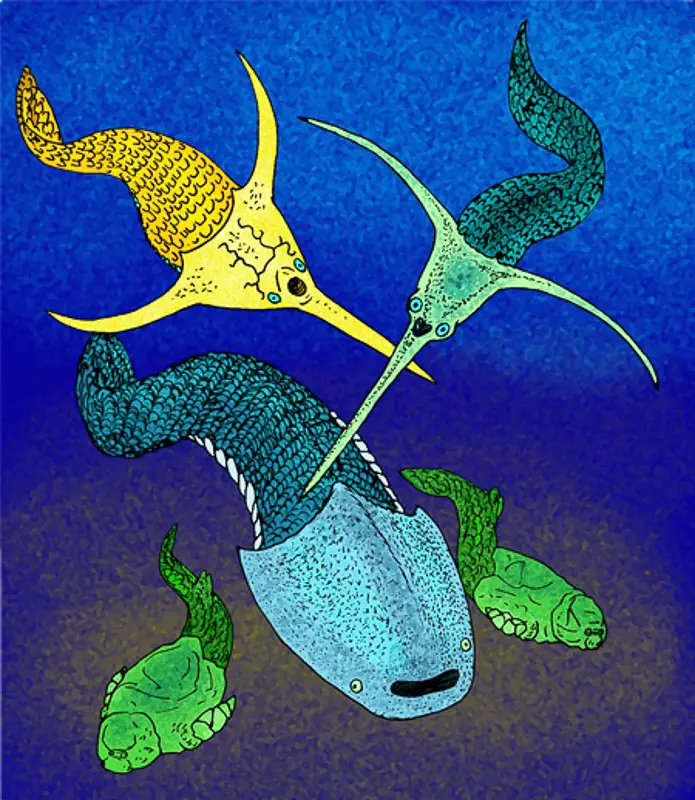Table of Contents
Class Ostracodermi:
Class Ostracodermi include the primitive Vertebrate fossil found and they help to study the ancestral Vertebrate. They are fish-like jawless Vertebrate known as Ostracoderms. The present-day Cyclostomata also evolved from the Ostracoderm and there are many similarities between them so they are placed under a common group Agnatha.
Before Ostracoderms, there are no fossil records for the primitive Vertebrate so we did have not much idea about the primitive Vertebrate before Ostracoderms. But the Ostracoderm give us a clear idea of how Ostracoderms give rise to other Vertebrate.
When was Present Ostracoderms on Our Earth:
Ostracoderms was dominant during the late Silurian period to the middle Ordovician period and the timeframe was around 500 million years ago. They were exclusively marine and they are now extinct but they left their fossil remains in the rocks stratum. During the Silurian period and the Devonian period, they present in abundance, and during this time frame, they reach peak level. With time they evolved much and the present-day fossil evidence of Ostracoderm was actually a very evolved form. With time Ostracoderms give rise to Placodermi, Osteicthys, Chondricthys but suddenly they become extinct but the actual reason is unknown.
Most of the workers believe that the Ostracoderm was marine but some fossils were also observed in freshwater stream sediment so the marine habitat of Ostracoderm becomes doubt and some workers also believe that they were maybe freshwater habitat.

Important Features of Ostracodermi:
- They was small fish like animal around 10cm to 16cm in length.
- Body was dorso-ventrally flattened so most of the workers believe that they was bottom deweller not able to swim actively.
- The head was much larger as compared to remain part of the body and the head mostly covered with shield like scale.
- The body divided into head, trunk and tail, like head the whole body was armoured with scales.
- During their existence some predator arthropods live, the shield like armour in whole body help them to get rid from the Arthropods. As their body was highly armoured with bony sheild like dermal scales so they are also known as Ostracoderms or armoured fish or ‘bony skin’.
- The tail have heterocercal or hypocercal caudal fin, pectoral and pelvic fin was absent, only median fin present.
- They are jawless and the mouth of Ostracoderm do not show teeth.
- On head two lateral large sized eyes present but peculiarly they have a median pineal eye on head between the lateral eyes.
- On anterior side of pineal eye a single nostril open outside, mouth present on anterior side of head slightly ventral position.
- In Ostracoderms, sense organs include the sensory field area on head lateral line system, internal ear have 2 semicircular canals.
- In Ostracoderms there are no axial endosketon and vertebrae, their week fin system and dorso-ventrally flattened body suggest that they was bottom deweller and generally collect their food through filter feeding mechanism.

Classification of Class Ostracodermi:
The fossil found of Ostracoderm has many similarities in different aspects, based on the dissimilarity we classify Ostracoderms into two subclasses, subclass Monorhina and subclass Diplodhina.
Subclass Monorhina:
In subclass Monorhina the large-sized single nostril is present between the two lateral eyes on the head, on external appearance, the nostril looks like a slit.
On the basis of similarity and dissimilarity among different members of subclass Monorhina, we can classify superclass Monorhina into three orders, order Euphanerida, order Anaspida, and order Osteostraci.
Order Euphanerida:
- Members of order Euphanerida are considered as the ancestral Ostracoderms, they was abundant during Silurian period.
- Euphanerida have only a single genus and under this genus only one species is known, Jamoytius kerwoodi, they do not show gill slits.
- Their head was blunt and was not armoured with bony scale.
- On trunk there are clear indication for two lateral fins and one median dorsal fin.
- Their muscle show metameric segmentation as that of the myotomes in Branchiostoma.
Order Anaspida:
- They were abundant during Silurian and Devonian period, the body was small sized around 14 cm.
- In some members head was naked, in some cases the head was covered by shield like bony armour but the arrangements of scale was complicated.
- The trunk was heavily armored with several longitudinal sheild like scale.
- On their body several places show some spine like structure, along the mid-dorsal line a series of spine present, pectoral spine present as paired appendages, a spine present near anus region.
- On anterior side of pectoral spine 8 gill slits present in obliquely manner, on head mouth was present terminally and the eyes present laterally on the head.
- The tail have hypocercal caudal fin, the lower lobe is larger and they were active swimmers.
Order Osteostraci:
- The head is covered by only one sheild like scale, they were abundant during Silurian period and Devonian period.
- In Osteostraci the tail have heterocercal caudal fin, upper lobe large and most of the workers believe that Osteostraci give rise to Lamprey.
- On the head lateral eyes present much closer and have sensory field on the head.
- Gill slits present in large numbers and behind the gill slits paired palps act as pectoral fins.
Subclass Diplorhina:
The most important feature which separates them from the subclass Monorhina is the nostril is two rather than one and opens separately.
Order Heterostraci:
- They were abundant in Ordovician period and Devonian period, they show laterally compressed tail.
- The tail have large lower lobe, hypocercal, tail is covered by minute scales.
- The head is highly armoured with bony scale, body is large sized.
- On head the mouth present terminally and anterior part of snout extend into rostrum, lateral eyes are much widely place from each other.
- There are no sensory structure in them but lateral line is distinct, on right and left lateral side have single large gill slit.
- The large sized cephali shield show an extension in backward direction like a spine.
- The trunk is covered by large triangular scale, most of the workers believe that they give rise to the Hagfish.

Order Coelolepida:
- The body is much smaller and on external appearance body is fusiform, length around 10 cm.
- Tail maybe hypocercal or heterocercal, body is covered by minute scales.
- The lateral eyes on the head present much apart from each other and they have broad anterolateral flanges.
Reference Ostracodermi Characteristics Classification Timeframes
Detailed Study On
Ostracodermi and its important Feature
Classification of Class Ostracodermi
Phylogeny of Subphylum Vertebrata
An Overview of Classification in Subphylum Vertebrata
Subphylum Vertebrata and its Diversity
Cephalochordata Characteristics Features Classification Examples and Diagram
Urochordata Classification Morphology Characteristic Features
Characteristics Features of Hemichordata
General Comparison of Hemichordata Urochordata and Cephalochordata
Comparative Study of Digestive System in Hemichordata Cephaochordata and Urochordata
Hi Everyone!!! Welcome to Imaluop. Imaluop always try to learn some new and he want to share to other people. Here we will try to learn various topics on Science, specially on Biological Sciences.